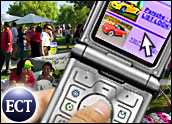
For mobile advertising to truly work, the mobile Web must work.
The promise of mobile advertising is obvious and immediate. We have all heard the mouthwatering stats by now:
- More folks around the world access the Web via the phone than they do from the PC.
- There are 2 billion interactive devices sitting in the pockets of subscribers from all corners of the globe and all walks of life at this very moment.
- The mobile phone is the most personal, most interactive and most frequently used device of all-time.
It’s no wonder that industry analysts predict the mobile advertising market will reach US$10 billion in just a few short years. The scenario is a marketer’s dream: an always on, always with you, two-way device that provides an unprecedented level of user information for the delivery of a device-specific, targeted message. Where do I sign up?
Not so fast. We still need to build an audience to provide those marketers with the reach they need to justify devoting a significant portion of their spend to mobile Internet advertising. The mobile Internet is growing every day. More and more people around the world turn to the mobile Web for “save time or waste time” activities. The mobile Web is familiar to them.
The sites they search for and choose to interact with are most likely the same sites they search for and interact with on the wired Web. So what is the rub? The rub is that the vast majority of the sites that subscribers are dialing up on these wonder devices are not properly adapted for the mobile environment. The result can be a very poor user experience. Sometimes it is just a plain mess. It’s kind of hard to build an audience for those drooling marketers to exploit on the back of a mess.
Enter the Adaptive Web
There is an army of folks out there who believe that attempting to squeeze a Web site designed for a 1024 x 768 computer screen down onto the tiny “third screen” of a mobile handset will not yield the optimal user experience.
Wired Web sites need to be adapted for the mobile environment. Adaptation covers all aspects of the wired-to-mobile experience: proper content selection, content sizing, introduction of mobile-only content, navigation flow, URL (uniform resource locator), etc. There are a lot of decisions to be made, and no shortage of opinions. There are also no absolutes. This is a fantastic time for experimentation.
As handsets are now shipped chock full of audio and video capabilities, as network speeds improve almost quarterly, as mobile search becomes more accessible and as new business models and near-ubiquitous reach attract top-tier creative talent to mobile content development, the opportunity to establish a brand identity in mobile has never been more compelling.
Golden Rules
To that end, I present to you the five golden rules of attracting and maintaining a mobile web audience:
ol.thisol { font-weight:bold }ol.thisol span {font-weight:normal }
- Your mobile Web site must load quickly. Get that site under 8k. It is the key size to assure a positive user experience on all major carriers in North America.
- Your site must be engaging. Just because you have built a “lite site,” it doesn’t mean it needs to be a long scroll of just plain text. Size your photos, paginate your articles and rotate your content. Make your site dynamic. As your wired site content updates, so should your mobile site. There is a lot that can be done to assure that the positive experience your visitors have on the wired Web will carry over to the mobile Web.
- The site must be easy to find. The concept of .mobi is a strong one, but not a compelling one. Sure, having every one of those 2 billion mobile phone owners get the memo to type .mobi at the end of their favorite URL would do the trick, but it is not going to happen. Publishers want to use their wired URL — end of story. They have zero interest in developing and marketing a new URL to attach to their brand. They also don’t want to lose the years of SEO (search engine optimization) credit they have built up in their wired URL. An intelligent re-director that identifies the incoming visitor query as mobile and presents the adapted version of the wired site will do the trick.
- Buy your keywords now. The keyword game is surprisingly untapped in mobile. Register with the usual suspects’ search engines for cross-carrier representation as well as with the carrier white-label search providers and make sure they know to present your beautiful new adapted mobile Web site, not their poorly transcoded version of what they think your mobile site should look like! That is a big pitfall to avoid.
- Integrate the ad units into the site build from the get-go. You got it. Those advertisers you just brought on-board to market to your visitors on your shiny new mobile Web site need to be properly mobilized as well. With a baked-in ad solution you will assure yourself that your ad partner will provide properly placed and formatted mobile advertisements for your site. Take advantage of integration opportunity to minimize key strokes and page loads to get to ad landing pages. Make sure all ads you run on your new site have a “back” button to give your visitors the option to return to where they came from.
The interaction with an advertisement on your site is as much a reflection of your brand as it is the advertiser’s. Take pains to review the ads submitted for your approval. Make sure they have a compelling call-to-action and follow the Mobile Marketing Association’s guidelines, as well as the previous mentioned rules in regards to a compelling and properly constructed landing page. Make sure key strokes are limited, field entries are minimized and that you have explored the new destination to which your visitors are being whisked away.
The results of properly formatted sites with adapted content and mobilized advertising are already being realized. Off-carrier deck site traffic is growing by leaps and bounds across all categories. Click-through rates are off the charts, hovering between 3 and 6 percent for premier advertiser campaigns (standard wired Web click-through rates hover between 0.1 and 0.2 percent).
Search accessibility will continue to improve and become front-and-center with this year’s holiday season handset turnover. Of course, the level of awareness and conversation about the mobile Web has skyrocketed thanks to Mr. Jobs and our friends at Apple. It is an exciting cocktail of converging interests and approaches, and clearly an advertising medium worth exploring today.
Andy Miller is CEO of Quattro Wireless, which has developed a technology platform that automatically creates adaptive mobile Web sites for publishers with tightly integrated, mobile-optimized advertising formats for advertisers.















































Social Media
See all Social Media